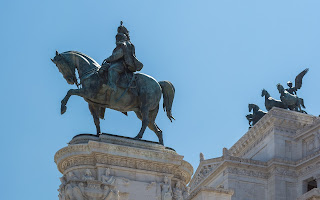NEW - Vittorio Emanuele II Monument - Rome landmark
‘Altar of the Fatherland’ built to honour unified Italy’s first king
The foundation stone of Rome’s huge Monument to Vittorio Emanuele II was laid on this day in 1885 in the presence of his son and successor Umberto I and his family. The monument, which took half a century to fully complete, occupies a site on the northern slope of the Capitoline (Campidoglio) Hill on the south-eastern side of the modern city centre, a few steps from the ruins of the Forum, the heart of ancient Rome. Built in white Botticino marble, the multi-tiered monument is 135m (443 ft) wide, 130m (427 ft) deep, and 70m (230 ft) high, rising to 81m (266ft) including the two statues of a chariot-mounted winged goddess Victoria on the summit of the two propylaea. Its appearance has earned it various nicknames, ranging from the ‘wedding cake’ to the ‘typewriter’, although it is officially known as Vittoriano or Altare della Patria. The Altar of the Fatherland is actually just one part of the monument, at the front and in the centre, consisting of an inset statue of the goddess Roma and the Tomb of the Unknown Soldier, where two soldiers guard an eternal flame. Above it is a large bronze horse-back statue of Vittorio Emanuele II himself on a central plinth in front of the broad upper colonnade. Read more…
____________________________________
Michele Sindona - fraudster and killer
Failed banker ordered murder of investigating lawyer
The shadowy banker Michele Sindona, who had links to underworld figures in Italy and America as well as prominent politicians, died in hospital in the Lombardy town of Voghera, 70km (43 miles) south of Milan, on this day in 1986. His death, attributed to cyanide poisoning, came four days after he had been sentenced to life imprisonment for ordering the killing of a lawyer investigating the collapse of his $450 million financial empire. His own lawyer claimed Sindona had been murdered but although it was never established beyond doubt, the circumstances of his death, caused by drinking coffee laced with the poison at breakfast in Voghera's maximum-security prison, pointed towards suicide. During his chequered career, which also saw him sentenced to 25 years' jail in America for fraud following the failure of the Franklin National Bank on Long Island, Sindona had links with Mafia bosses in Sicily and New York, with the illegal Propaganda Due masonic lodge and with the controversial head of the Vatican Bank, the American Archbishop, Paul Marcinkus. He had close ties with another Vatican Bank client who met an untimely death, Roberto Calvi. Read more…
_____________________________________
Nino Manfredi - actor and director
Totò fan became maestro of commedia all’italiana
The actor and director Saturnino ‘Nino’ Manfredi, who would become known as the last great actor of the commedia all’italiana genre, was born on this day in 1921 in Castro dei Volsci, near Frosinone in Lazio. Manfredi made more than 100 movies, often playing marginalised working-class figures in the bittersweet comedies that characterised the genre, which frequently tackled important social issues and poked irreverent fun at some of the more absurd aspects of Italian life, in particular the suffocating influence of the church. He was a favourite of directors such as Dino Risi, Luigi Comencini, Ettore Scola and Franco Brusati, who directed him in the award-winning Pane and cioccolata (Bread and Chocolate), which evoked the tragicomic existence of immigrant workers and was considered one of his finest performances. It helped him fulfil his dream of following in the footsteps of his boyhood idol Totò, the Neapolitan comic actor whose eccentric characters took enormous liberties in mocking Italian institutions, and to be spoken off in the company of Ugo Tognazzi, Vittorio Gassman and Alberto Sordi as a true maestro of commedia all’italiana. Read more…
_____________________________________
'La Castiglione' – model and secret agent
Beautiful woman helped the cause of Italian unification
Virginia Oldoini, who became known as La Castiglione, was born on this day in 1837 in Florence. She became the mistress of the Emperor Napoleon III of France and also made an important contribution to the early development of photography. She was born Virginia Oldoini to parents who were part of the Tuscan nobility, but originally came from La Spezia in Liguria. At the age of 17 she married the Count of Castiglione, who was 12 years older than her, and they had one son, Giorgio. Her cousin was Camillo, Count of Cavour, who was the prime minister to Victor Emmanuel II, the King of Sardinia, later to become the first King of a united Italy. When the Countess travelled with her husband to Paris in 1855, Cavour asked her to plead the cause of Italian unity with Napoleon III. Considered to be the most beautiful woman of her day, she became Napoleon III’s mistress and her husband demanded a separation. During her relationship with Napoleon III she influenced Franco-Italian political relations, mingled with European nobility and met Otto von Bismarck. She became known both for her beauty and elaborate clothes. Read more…

.jpg)








.jpg)
.jpg)

.jpg)
.jpg)
